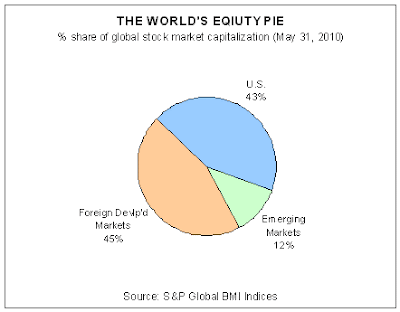"The rapid growth of emerging economies has led to a shift in economic power," the OECD reported earlier this month, offering quantitative support for what everyone already knows. "Forecasts based on analysis by late economist Angus Maddison suggest that the aggregate economic weight of developing and emerging economies is about to surpass that of the countries that currently make up the advanced world." The economic and financial turmoil of late is accelerating the trend, according to analysis from the OECD.
In 2000, non-member OECD economies (generally those nations outside the rich developed world) represented a 40% share of the global economy, based on purchasing power parity. This year, the share has risen to 49%, and it's projected to reach 57% by 2030.
But economic weight doesn't translate into market influence, at least not yet as measured by relative market capitalizations. At the end of last month, emerging market equities represented about 12% of global market cap, according to figures published by Standard & Poor's. That's up sharply from a decade ago, when emerging markets were a mere 1% of global equity capitalization. But 12% still falls short of the commensurate economic influence of so-called emerging markets.

Some of this mismatch is related to the varied evolution of each country's capital markets, which is dependent on local customs, preferences, and so on. For instance, China's equity market cap is still just 1% of its economy, based on purchasing power parity GDP estimates via the CIA World Factbook and S&P market data. By comparison, the U.S. stock market is valued at roughly 84% of its GDP.
In fact, emerging markets generally tend to post relatively low market caps vs. their economies while developed nations have richly valued stock markets in comparison with their GDPs. If the OECD forecast is correct for continued growth in emerging markets' relative share of global GDP, the trend implies that rebalancing of market cap in the world's equity markets will also roll on.
What does this mean for investing? One message is that global equity allocations should, at the very least, hold a dedicated stake in emerging market stocks as a strategic matter. Thanks to the proliferation of ETFs and mutual funds in this space, tapping this slice of the world's capital markets is inexpensive and precise. For instance, one of the leading broad-market indexing choices listed in a recent review of these funds in The Beta Investment Report highlighted Vanguard Emerging Markets (VWO).
Earlier this week, I wrote about the power of a broadly diversified, multi-asset class market strategy over the long haul. As it turns out, passively buying all the major asset classes and letting it run has done a decent if unspectacular job of turning a profit. Over the past decade, for instance, my newsletter's proprietary Global Market Index has returned about 3.6% a year. Not bad for the so-called dumb money compared with, say, a roughly flat return for U.S. stocks over the same stretch. In Monday's post I also noted that an updated view of modern portfolio suggests that we should intelligently customize the unmanaged market portfolio in the quest for earning a better return, lowering risk without sacrificing performance, or some of each. Holding an above-market-weight allocation to emerging markets is one possibility, and arguably a compelling one, in part based on the analysis above.
How much should we hold in emerging markets? If you had no view on this corner of the equity market you could argue that a 12% weight in these stocks within an overall equity allocation is neutral, as per the analysis above. Materially altering that allocation (up or down) is risky, perhaps productively so. The same can be said for many other factors that collectively make up the broadly defined market portfolio.
For many investors, however, this is putting the cart before the horse. A neutral weighting for emerging markets is 12% of a broad equity allocation at present. Yet many investors hold far less than that share, if any. Will that change? Probably, which is part of the reason why holding a market-weight allocation, if not more so, is compelling. As Ben Graham famously observed, in the short run the market's a voting machine; in the long run, it's a weighing machine. In other words, economic reality dictates prices eventually, but not always immediately. Or, if you prefer, the market's efficient in the long run, but provides opportunity (degrees of inefficiency relative to a long-term equilibrium perspective) in the short term. Emerging markets are but one of the possibilities in a world brimming with betas (or asset pricing anomalies, as some like to say).
Over time, more investors around the world will hold more emerging market equities. No guarantees, of course. But unless you're wildly pessimistic on the long-term growth trend in the developing world overall, the writing on the proverbial investment wall looks rather conspicious. What's the catch? Short-term volatility can be vicious. There's still no free lunch, but for those with nerves of steel, a disciplined investment strategy and a capacity for exploiting contrarian-based trends, there's still plenty of opportunity. Par for the course.
This post has been republished from James Picerno's blog, The Capital Spectator.
1 comment:
I think you make a very interesting point. The rebalancing of economic power is happening at an accelerating pace. In the next blog the same topic is discussed:
http://point-consulting.blogspot.com/2010/10/trends-that-are-shaping-world-part-1.html
Post a Comment